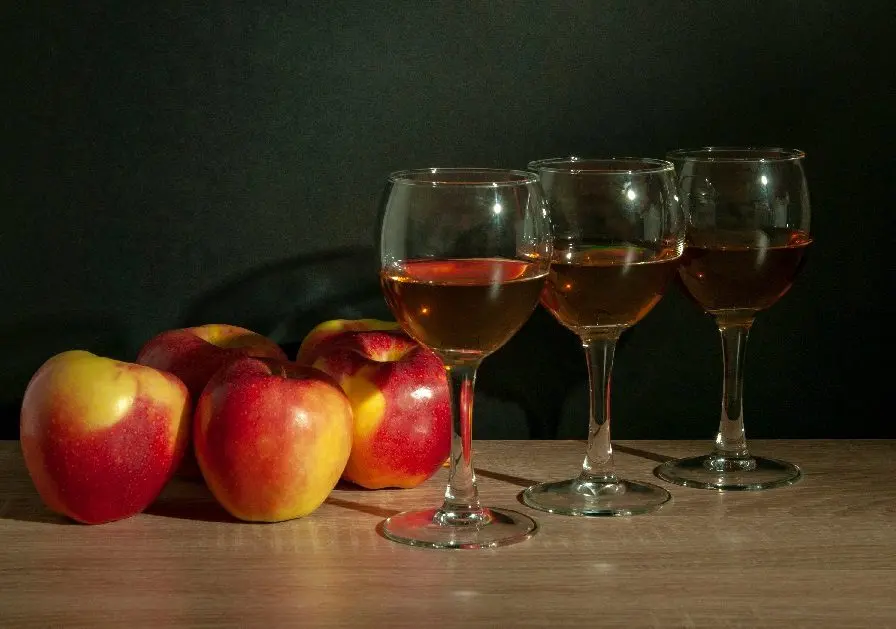Contents
Pommo is a popular alcoholic drink in northwestern France, obtained by mixing freshly squeezed apple juice with apple brandy (calvados in Normandy, lambig in Brittany). Pommo goes well with melon and blue cheese, desserts, chocolate and apple pastries.
Production technology
Two parts of apple must (not fermented freshly squeezed apple juice) is mixed with one part of aged calvados. The result is a drink with a strength of 16-18 degrees, which is left to “ripen” in oak barrels for 14-30 months. Strong brandy does not allow the juice to ferment (ferment), and due to contact with the pommo tree, it acquires an amber color and an exquisite aroma. In the taste of the finished drink, tones of vanilla, caramel, toffee are felt.

Sometimes pommo is called fortified cider, but this is fundamentally wrong, since cider is a product of the fermentation of apple juice, in fact, a weak, often carbonated, apple wine. In turn, pommo is a tincture of apple juice in strong alcohol, aged in barrels.
Pommo is made on the territory of three appellations of France – in Normandy, Brittany and Maine. Since 1991, this alcoholic beverage has had the status of a name controlled by origin. This means that only manufacturers located in the indicated regions and complying with the production technology approved at the legislative level have the right to put the name “Pommeau” on the label.

Pommeau de Bretagne
The appellation covers more than 300 farms specializing in the production of cider. The rules strictly control the type and origin of apples, the proportional ratio of different varieties, the sugar content in the juice, the quality of apple brandy (lambiga), the “aging” time in barrels. More than 60 varieties of bitter, bittersweet, sweet and sour apples grow in Breton orchards, all of which can be used to produce pommo.
The production of the drink is divided into three stages:
- Apples are harvested, sorted, washed, cut into small pieces and juice is pressed from them.
- The resulting juice is mixed with apple brandy aged in oak barrels for at least a year.
- Left in an oak barrel for a period of at least 14 months (most often – at least two years).
Pommeau de Bretagne has a balanced bitter-sweet-sour taste and rich aroma. With aging, notes of dried fruits, apricots, almonds, caramel, cocoa, honey, cinnamon and licorice appear in the bouquet. When serving, the drink is cooled to 8-10°C and served with foie gras, cheese, desserts, white meat, oysters, scallops. A mixture of juice and apple distillate can act as both an aperitif and a digestif.

Pommeau de Normandie
Appeared in the 1970s, but was officially recognized only in 1986, and received the status of a name controlled by origin only in 1991. To be called a Pommo de Normandie, the drink must be made from apples grown in Calvados AOC and contain at least 70% bitter or bittersweet varieties. The finished mixture is aged in oak barrels for at least 14 months.
The production technology of this type of pommo is no different from the Breton variation (except for the origin of apples and the type of brandy, of course), it is served with the same snacks and at the same temperature.
Pommeau de Maine
The appellation appeared in 2008 and so far its products are little known on the world market. The technology is the same as in Brittany. Producers are required to use local raw materials – 30 varieties of sweet and bitter apples. After blending, the resulting mixture is kept for 2-3 years, as a result, the drink is darker than in other appellations.
Drinking culture involves chilling the pommo de Maine to 8-10°C, with white meat, hot oysters, Roquefort cheese, foie gras, chocolate fudge and apple pie usually served as appetizers.

Famous pommo brands
It is difficult to single out the main producer – in fact, all Normandy and Breton cider farms supply the market with pommo. In particular, we can name the following brands:
- Christian Drouin;
- Lemorton;
- Domaine Dupont;
- Pierre Huet.









